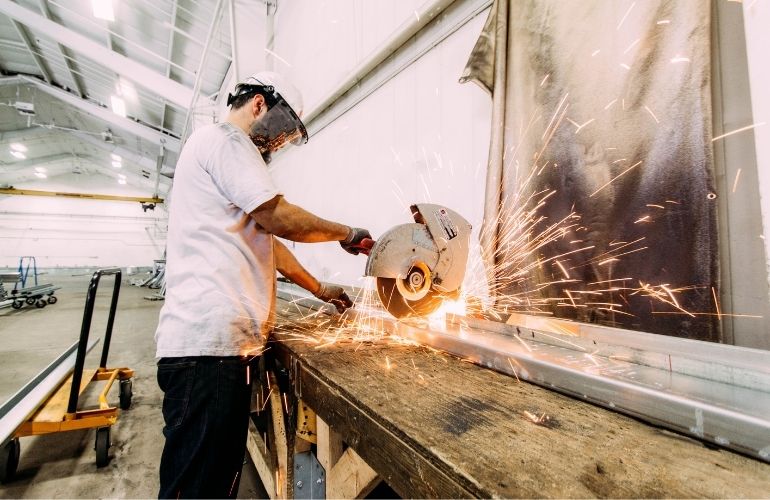6 Unpredictable Ways of Reducing Waste Through Supply Chain Management
Supply chain waste is a major problem that businesses of all sizes face. It can lead to environmental damage, financial losses, and a decrease in...
6 min read
Ömer Ali Güneş
:
Aug 23, 2023 11:19:16 AM
In a world where resources are finite and environmental concerns are growing, the traditional linear economy model's shortcomings are becoming glaringly evident.
This linear approach, marked by a relentless cycle of extraction, production, consumption, and disposal, has led us down a path of unsustainable resource depletion, waste accumulation, and environmental degradation. It's a model that thrives on a "take, make, dispose" mindset, and it's reaching its breaking point.
Enter the concept of the circular economy—a radical departure from the linear status quo. The circular economy model presents a transformative vision for the future—one where resources are not just conserved but regenerated, and waste is not an end but a new beginning.
While the circular economy philosophy has garnered attention in various sectors, its application in logistics and operations holds immense promise, redefining the way we move goods and manage processes.
In this blog post, we embark on a journey from the linear to the circular, exploring the pivotal role of the circular economy model in revolutionizing logistics and operational practices. We'll delve into the principles that underpin this transformative approach and dissect the ways it can be integrated into the intricate web of supply chains and operations.
1. Understanding the Circular Economy Model
2. Applying Circular Economy Principles to Logistics
3. Circular Economy in Operational Process
4. Benefits of Circular Economy Adoption in Logistics and Operations
6. Successful Circular Economy Implementations
RELATED:
6 UNPREDICTABLE WAYS OF REDUCING WASTE THROUGH SUPPLY CHAIN MANAGEMENT
1. Understanding the Circular Economy Model
At its core, the circular economy model represents a fundamental shift in how we approach economic systems.
Unlike the linear economy, which hinges on the continuous extraction of raw materials, manufacturing, and eventual disposal, the circular economy is an elegant dance of regeneration, reuse, and restoration.
This innovative framework operates on three foundational principles that lay the groundwork for a more sustainable and harmonious relationship between human activities and the environment.
Central to the circular economy ethos is the concept of designing products and systems to extend their lifecycles and enable them to be regenerated. This involves considering the longevity, reparability, and recyclability of products right from the design stage.
Unlike the linear economy, which often discards products after a single use, the circular economy thrives on the principles of reuse and remanufacturing. Products are designed to be disassembled easily, enabling components to be repurposed or refurbished.
Recycling takes center stage in the circular economy's endeavor to maintain the value of materials within the economic system. Efficient recycling processes ensure that materials are continuously looped back into production, reducing the need for virgin resources.
 Central to the circular economy ethos is the concept of designing products and systems to extend their lifecycles and enable them to be regenerated.
Central to the circular economy ethos is the concept of designing products and systems to extend their lifecycles and enable them to be regenerated.
2. Applying Circular Economy Principles to Logistics
The circular economy's transformative potential isn't confined to product design and manufacturing alone. It extends its reach into the realm of logistics, where innovative strategies can reshape the way goods are transported, distributed, and managed.
Circularity in logistics starts with a reassessment of traditional transportation and distribution methods. Embracing sustainable transportation options like electric vehicles, hybrid trucks, and alternative fuels can significantly reduce carbon emissions.
Reverse logistics, a key pillar of the circular economy in logistics involves the recovery and reutilization of products and materials at the end of their lifecycle. Instead of discarding used products, businesses can implement processes for collecting, refurbishing, and reselling them.
Incorporating digital technologies can amplify the circular economy's impact on logistics. Advanced analytics, real-time tracking, and artificial intelligence-driven systems can enhance supply chain visibility and efficiency.
Predictive analytics can aid in demand forecasting, minimizing overstock, and reducing waste. Additionally, smart technologies can facilitate better communication and collaboration among stakeholders, enabling streamlined processes and minimizing resource waste.
RELATED:
THE ROLE OF BIG DATA IN LOGISTICS AND SUPPLY CHAIN MANAGEMENT
3. Circular Economy in Operational Processes
As the circular economy model extends its influence from logistics to operational processes, it brings about a fundamental reimagining of how businesses approach product design, consumption models, and resource utilization. By incorporating circular economy principles into these areas, companies can create a more sustainable, resilient, and resource-efficient operational ecosystem.
Product design lies at the heart of the circular economy's influence on operational processes. Instead of creating products with planned obsolescence in mind, businesses can prioritize longevity, repairability, and recyclability.
This entails using durable materials, modular components, and standardized interfaces that make it easier to repair and upgrade products. Designing products with recycling in mind ensures that at the end of their lifecycle, materials can be efficiently recovered and reused in new production cycles.
Sharing and collaborative consumption platforms have gained prominence as potent tools for implementing circular economy principles. These platforms facilitate the sharing or renting of goods and services among multiple users, thus extending the lifespan of products and reducing the need for new production.
Businesses can participate in or create such platforms, allowing customers to access products without the need for full ownership. From tools and appliances to vehicles, the sharing economy promotes efficient resource use and minimizes waste.
 Sharing and collaborative consumption platforms have gained prominence as potent tools for implementing circular economy principles.
Sharing and collaborative consumption platforms have gained prominence as potent tools for implementing circular economy principles.
4. Benefits of Circular Economy Adoption in Logistics and Operations
The adoption of circular economy principles in logistics and operational processes doesn't just pave the way for a more sustainable future—it also brings a multitude of tangible benefits to businesses and the environment alike. This shift in approach heralds a new era of efficiency, innovation, and responsible resource management.
One of the most immediate and profound benefits of embracing the circular economy is the reduction in carbon emissions and overall environmental impact.
By designing products for longevity, implementing reverse logistics, and optimizing transportation strategies, businesses can significantly cut down on waste generation, energy consumption, and greenhouse gas emissions. This translates into a lighter environmental footprint and a more sustainable planet.
Circular economy practices inherently drive resource efficiency. Businesses that design products for durability and repairability experience fewer warranty claims and returns.
In a world where consumers are increasingly conscious of their environmental impact, embracing circular economy practices resonates with responsible consumption.
Businesses that prioritize sustainability and circularity not only gain customer trust but also enhance their brand image. The commitment to reducing waste and conserving resources reflects positively on corporate social responsibility initiatives, fostering stronger relationships with customers and stakeholders.
 By designing products for longevity, implementing reverse logistics, and optimizing transportation strategies, businesses can significantly cut down on waste generation, energy consumption, and greenhouse gas emissions.
By designing products for longevity, implementing reverse logistics, and optimizing transportation strategies, businesses can significantly cut down on waste generation, energy consumption, and greenhouse gas emissions.
5. Challenges and Barriers
While the adoption of circular economy principles in logistics and operations holds the promise of transformative benefits, it's important to acknowledge the challenges and barriers that businesses may encounter on this journey toward sustainability and circularity. Navigating these hurdles requires commitment, collaboration, and a willingness to embrace change.
Transitioning from a linear to a circular economy requires upfront investments in infrastructure, technology, and process reengineering. Businesses must be prepared to allocate resources for redesigning products, setting up reverse logistics systems, and implementing waste reduction measures.
RELATED:
8 BENEFITS OF RESILIENT SUPPLY CHAINS
While these initial costs may seem daunting, they are often outweighed by the long-term benefits in terms of cost savings and environmental impact reduction.
The linear economy model has ingrained a culture of ownership in both businesses and consumers. Shifting this mindset to one of shared usage or service-based consumption can be a significant challenge.
Businesses must find ways to communicate the value of access over ownership, highlighting the convenience, cost savings, and sustainability benefits of such models. Regulations and policies in many regions are often designed to accommodate traditional linear economic models.
Addressing these challenges requires a holistic approach that combines strategic planning, innovation, collaboration, and adaptability. The journey from linear to circular is not without its obstacles, but it's a journey that holds the promise of a more sustainable and prosperous future for businesses and the planet.
6. Successful Circular Economy Implementations
The transition to a circular economy in logistics and operations is not just theoretical—it's a practical journey that forward-thinking companies are already embarking upon. These case studies serve as beacons of inspiration, showcasing the tangible benefits and innovative strategies that arise from embracing circularity.
6.1.Patagonia
Outdoor clothing company Patagonia has become a poster child for sustainable and circular practices. By offering repair services for its products, encouraging customers to fix and reuse instead of replacing them, and incorporating recycled materials into its designs,
Patagonia has extended the lifespan of its products and reduced waste. This approach not only aligns with their environmental values but also strengthens customer loyalty and brand reputation.
 Patagonia has extended the lifespan of its products and reduced waste.
Patagonia has extended the lifespan of its products and reduced waste.
6.2.Philips Lighting
Philips Lighting, now known as Signify, adopted a circular economy model by shifting from selling light bulbs to offering lighting as a service. By retaining ownership of the products, Philips maintains responsibility for repairs, replacements, and upgrades. This incentivizes product durability and drives innovation in energy-efficient lighting solutions, reducing both waste and energy consumption.
6.3.Loop
Loop, a circular shopping platform, partners with leading consumer goods companies to offer products in reusable, refillable packaging. Customers receive products in durable containers that are collected, cleaned, and refilled after use. This approach significantly reduces single-use packaging waste while maintaining the convenience of everyday consumption.
Conclusion
In an era defined by growing environmental concerns and the imperative for sustainable practices, the circular economy model emerges as a beacon of hope and possibility.
The journey from a linear to a circular economy is not just a paradigm shift—it's a transformative movement that holds the power to reshape how we produce, consume, and manage resources.
RELATED:
5 THINGS THAT WILL MAKE YOUR SUPPLY CHAINS MORE SUSTAINABLE

Supply chain waste is a major problem that businesses of all sizes face. It can lead to environmental damage, financial losses, and a decrease in...

Supply chain sustainability has become an increasingly important topic in recent years, as businesses around the world strive to minimize their...

Due to the changing and developing technology, the production and logistics processes have also required to be simplified. With the effect of the...